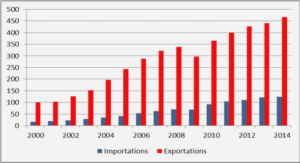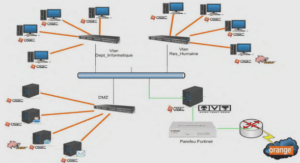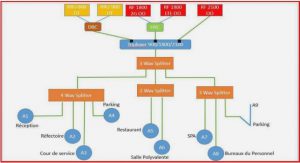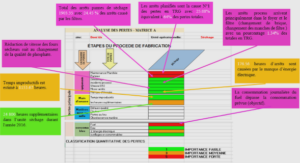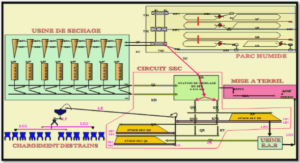Hearing protection technologies
Passive HPDs
Passive HPDs reduce the background noise mechanically based on their shape and material composition. The amount of attenuation procured by passive HPDs (in the form of earplugs or earmuffs) depends on the material used and the shape (or length for earplugs) of the HPD.
Some HPDs are designed for uniform attenuation over the frequency range, while others have a level-dependent attenuation.
Passive HPDs with uniform attenuation are designed to reduce the external signals by about 10 dB from 125 to 8000 Hz uniformly (Berger and Voix, 2015). The advantage of uniform HPDs is their identical attenuation across all the frequency components contrary to other HPDs which attenuate the high frequencies more than the low frequencies and which may cause a coloration of the passively transmitted sounds (Berger and Voix, 2015)
Active HPDs
Active HPDs are also known as electronic HPDs and are equipped with a powered digital or analog circuit to process the external sounds before their transmission/obstruction to the protected ear. (Casali, 2010) divided active HPDs into four types, three of which will be described here after: Active Noise Reduction (ANR) devices, Electronically-Modulated Sound Transmission Devices and Electronic Tactical Communications and Protection Systems (TCAPS). The fourth type includes HPDs with dosimetry measurements.
The main and most popular task that current Active HPDs offer is Active Noise Reduction (ANR) (also known as Active Noise Control or Noise Cancellation), which can be done using analog or digital circuits and consists of cancelling the external sound wave by adding to it the same sound wave but phase inversed. ANR technology is currently becoming an important functionality not only in hearing protection, but also in communication systems such as headphones and wireless communication devices (Brimhall et al., 2002).
Advanced electronic HPDs
Recently, advanced hearing protection devices have been developed. They are currently being manufactured. Among these advanced devices are smart earplugs from Sensear Pty Ltd (Belmont, Australia) that perform noise reduction to enhance the quality of speech and improve its intelligibility. However, these smart earplugs do not block the external signal if no speech is present, but only reduce it to keep the wearer aware of the external environment. The continuous transmission of processed signal to the ear is annoying the wearer and may yield to an excess in noise exposure since the wearer can increase and reduce the volume of the processed sound.
Other advanced HPDs have been developed such as the Nacre QUIETPRO Intelligent Hearing System (Trondheim, Norway) which plays the role of: an amplifier when the external sound is low to transmit to the ear, the role of a level limiter when the level increases, and noise canceller (ANR) when the level of the external noise exceeds a certain threshold. However, since these HPDs act like an active noise canceller in high levels of noise, they cannot detect useful signals such as speech or warning signals, which may hinder safety and face-to-face oral communication.
Speech in telecommunication technologies
For the purposes of the current thesis, telecommunication technologies involving speech, and more particularly speech detection in noise, are investigated since the techniques used in telecommunication are embedded in DSP and work in real-time such as in mobile telephony. Speech represents the first tool that humans use to communicate with each other. In the last decade, speech has also been used by humans to communicate with machines that are provided with speech technology such as automatic speech recognition (ASR) (O’Shaughnessy, 2000).
Basics of speech production
A speech signal is produced by a speaker in the form of a wave that propagates through the air to reach the ear of the listener. The characteristics of the speech signal vary depending on the movement of the articulators which are located in the vocal tract (O’Shaughnessy, 2000).
Among these articulators we have: the lips, the tongue, the teeth, the palate, the jaw, etc. The speech production process can be seen as a filtering operation in which a sound source excites the filter. In the human speech production system, this filter corresponds to the vocal tracts and helps to attenuate and amplify certain frequencies (modulate the sound). The sound source or (exciter) can be periodic and generate a voiced speech signal, or aperiodic and generate an unvoiced speech signal. Voiced speech is generated in the larynx where the air is interrupted by the vibrations of the vocal cords, which open and close periodically, whereas for unvoiced speech, the air is not interrupted by the vibration of the vocal cords, but passes through the vocal tract directly. Unvoiced speech is a random signal similar to a noise signal modulated by the vocal tracts.
Voice activity detection
Nowadays, almost all the existing speech-based applications rely on speech detection algorithms to discriminate between speech and non-speech segments. In the literature, speech detection is known as Voice Activity Detection (VAD). The first VAD algorithm with widespread usage was developed for mobile telephony in 1989 (Freeman et al., 1989) for the pan-European digital cellular mobile telephone service (Global System for Mobile: GSM). The principle behind the need for VAD within a mobile telephony application was to detect non-speech segments which could then be encoded with lower bit rates, relative to speech segments, thus lowering the overall transmission rate. Since then, more advanced VAD algorithms have been proposed, such as the one used in the International Telecommunications Union (ITU-T) Recommendation G.729b in 1996 (ITU T, 1996) and the one used in the adaptive multi-rate (AMR) codec from the European Telecommunication Standard Institute (ETSI) (ETSI, 1999). The latter VAD system is based on a combination of different speech features and exemplifies one of the major shifts from the earlier generation energy- or periodicity-based solutions.
Hearing aid technologies
Hearing aid principles
As a consequence of excessive noise exposure, NIHL is an irreversible disease. While the intelligibility of speech signals in a noisy environment is already a difficult task for normal hearing people, it is much more difficult for the hearing impaired. In noisy environments, the speech signal must be 30 dB higher than the speech signal for persons with hearing loss than for a person with normal hearing for them to perceive it in the same way (Baer and Moore, 1994).
Currently, the only solution for hearing impaired people is to wear hearing aids. Primarily, hearing aids have been developed to amplify the incoming signals, and more recently, they have been developed to increase speech understanding and listening comfort in noisy environments where speech tends to be masked by noise.
Noise reduction in hearing aids
Noise reduction is performed to reduce the background noise, increase listening comfort, and thus, increase speech understanding for the hearing impaired (Kuk et al., 2002), (Mueller et al.,2006) (Bentler et al., 2008). When speech is corrupted by noise, the frequency components of noise may overlap the frequency components of speech which leads to frequency masking of speech by noise.
In order to perform noise reduction, all hearing aids manufacturers follow the same steps: Signal detection, Signal analysis, Decision and noise reduction.
The detection stage is generally composed of several sub-blocks. The first block consists of dividing the signal into different frequency bands. Frequency-band processing is currently used by all hearing aid manufacturers to analyse each frequency band independently and extract the relevant characteristics for speech. These characteristics are subsequently compared to reference characteristics to make a decision.In addition to the use of the same steps to perform noise reduction, almost all hearing aid manufacturers use modulation characteristics to detect speech and reduce the background noise.
|
Table des matières
INTRODUCTION
0.1 Problem definition and context
0.2 Thesis objectives
0.3 Scope of the thesis
0.4 Challenges and opportunities
0.4.1 Challenges
0.4.2 Opportunities
0.5 Methodology
0.5.1 Algorithm development
0.5.2 Algorithm evaluation and validation
0.5.3 Algorithm hardware implementation and system evaluation
0.6 Contributions
0.6.1 Scientific contributions
0.6.2 Technological contributions
0.7 Outline of the thesis
CHAPTER 1 SMART HEARING PROTECTION DEVICES: A LITERATURE REVIEW
1.1 Introduction
1.2 Hearing protection technologies
1.2.1 Passive HPDs
1.2.2 Active HPDs
1.2.3 Advanced electronic HPDs
1.2.4 Summary
1.3 Speech in telecommunication technologies
1.3.1 Basics of speech production
1.3.2 Speech analysis
1.3.2.1 Time domain speech analysis
1.3.2.2 Frequency domain speech analysis
1.3.2.3 Time-Frequency speech analysis
1.3.3 Speech in noise
1.3.4 Voice activity detection
1.3.5 Summary
1.4 Hearing aid technologies
1.4.1 Hearing aid principles
1.4.1.1 Analog hearing aids
1.4.1.2 Digital hearing aids
1.4.2 Noise reduction in hearing aids
1.4.3 Summary
1.5 Methodology for the evaluation and validation of speech based systems
1.5.1 Algorithm evaluation
1.5.1.1 Evaluation of voice activity detection algorithm
1.5.1.2 Evaluation of noise reduction algorithm
1.5.2 System evaluation and validation
1.6 Literature review synthesis
CHAPTER 2 ECHO THRESHOLD BETWEEN PASSIVE AND ELECTRO-ACOUSTIC TRANSMISSION PATHS IN DIGITAL HEARING PROTECTION DEVICES
2.1 Abstract
2.2 Introduction
2.3 Digital hearing protection device
2.3.1 Sound transmission paths
2.3.2 HPD characteristics
2.4 Methodology
2.4.1 Stimuli generation
2.4.1.1 Types of signals
2.4.1.2 Signal processing
2.4.2 Subjective test protocol
2.5 Data analysis and results
2.5.1 Spectrogram analysis
2.5.2 Descriptive statistics
2.5.3 Analysis of the variance
2.5.4 Determination of the echo threshold
2.6 Discussions and conclusions
CHAPTER 3 VOICE ACTIVITY DETECTION SYSTEM FOR SMART EARPHONES
3.1 Abstract
3.2 Introduction
3.3 The smart earphone
3.4 The proposed VAD algorithm
3.4.1 Windowing
3.4.2 Feature extraction
3.4.2.1 Filterbank
3.4.2.2 Energy based feature
3.4.2.3 Normalization
3.4.3 VAD’s decision
3.4.3.1 The decision thresholds
3.4.3.2 Start and end of speech confirmation parameters
3.5 Off-line parameters optimization
3.5.1 Objective function
3.5.2 Audio signals used for off-line optimization
3.5.3 Genetic algorithm for off-line parameters optimization
3.6 Experiments and validation
3.6.1 Validation database
3.6.2 Performance evaluation
3.7 Hardware implementation
3.7.1 DSP overview
3.7.2 Hardware implementation
3.7.3 VAD real-time tests and validation
3.8 Discussions and conclusions
CHAPTER 4 NOISE REDUCTION OF SPEECH SIGNAL USING TIME-VARYING AND MULTI-BAND ADAPTIVE GAIN CONTROL
4.1 Abstract
4.2 Introduction
4.3 Proposed algorithm
4.4 Experimental methodology
4.4.1 Optimal cut-off frequency of the gain function
4.4.2 Objective evaluation
4.4.3 Subjective evaluation
4.4.3.1 Musical noise assessment
4.4.3.2 Overall quality evaluation
4.5 Results and discussions
4.5.1 Objective test results
4.5.2 Subjective test results
4.5.2.1 Musical noise results
4.5.2.2 Overall quality results
4.6 Hardware implementation
4.6.1 DSP overview
4.6.2 Hardware implementation
4.6.3 Real-time test
4.7 Conclusions
CHAPTER 5 SYNTHESIS, CONTRIBUTIONS, RECOMMENDATIONS AND FUTURE WORK
5.1 Synthesis of the research work
5.2 Recommendations and future work
5.2.1 Recommendations
5.2.1.1 Algorithms benchmarking
5.2.1.2 VAD and noise reduction combination
5.2.1.3 VAD hardware parameters optimization
5.2.1.4 Adaptive Dynamic Range Compression: Parameters Optimization
5.2.1.5 Objective and Subjective evaluation of the S-HPD
5.2.1.6 Smart hearing protection device for hearing impaired people
![]() Télécharger le rapport complet
Télécharger le rapport complet

